#Megacyllene robiniae
Explore tagged Tumblr posts
Text
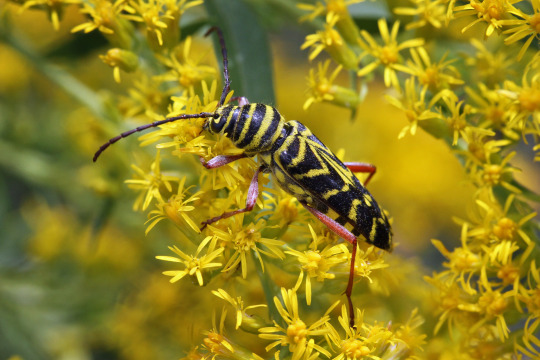
Locust borer (Megacyllene robiniae)
September 22, 2023
Southeastern Pennsylvania
#bug#bugs#photographers on tumblr#locust borer#beetles#coleoptera#bugblr#entomology#insects#insect#animals#nature#Megacyllene robiniae
272 notes
·
View notes
Text




















Walk with me: Mid-summer hike through a Central Appalachian forest. As summer hurtles toward its final explosive act, the forest's living things embrace urgent, primordial impulses triggered by shrinking daylight: to bloom, to seed, to feed, and to reproduce before the killing frost of Autumn shocks the earth into hibernation. In the deep forest, the fetid perfume of decaying fungi signals the countdown has begun. From top: a bumblebee traversing the fanning pink flowers of hollow-stemmed Joe-Pye weed (Eutrochium fistulosum); the maturing red stem and flowers of seedbox (Ludwigia alternifolia), also known as rattlebox and square-pod water-primrose, a very attractive wetlands annual with four-sided seed capsules; cowbane (Oxypolis rigidior), also known as common water dropwort, a delicate, marsh-loving member of the carrot family that also happens to be toxic; Allegheny hawkweed (Hieracium paniculatum), also known as panicled hawkweed, a spindly-stemmed member of the dandelion tribe; the lovely and hallucinogenic fly agaric (Amanita muscaria); a sprawling colony of sulphur shelf fungus (Laetiporus sulphureus), an edible delicacy otherwise known as chicken of the woods; a red eft (Notophthalmus viridescens); white wood aster (Eurybia divaricata); a twin set of common puffballs (Lycoperdon perlatum); the fungal version of suburban sprawl courtesy of orange moss agaric (Rickenella fibula); a gelatinous serving of orange witches' butter (Dacrymyces chrysospermus); a fiery clump of eastern Jack-o-lanterns (Omphalotus illudens); a potter wasp (Ancistrocerus campestris) drinking from the clumped white flowers of virgin's bower (Clematis virginiana); one of my all-time favorite critters, a locust borer (Megacyllene robiniae), taking its nectar fill from flat-top goldentop (Euthamia graminifolia), also known as grass-leaved goldenrod; a green metallic sweat bee (Augochloropsis ?) finding sustenance from parasol white-top (Doellingeria umbellata var. umbellata), also known as flat-top aster; and the intricate purple flowers of tall ironweed (Vernonia gigantea).

#appalachia#vandalia#west virginia#wildflowers#flora#summer#coopers rock state forest#glade run trail#insects#bumblebee#locust borer#potter wasp#green metallic sweat bee#amphibian#red eft#eastern newt#hollow joe-pye weed#seedbox#cowbane#allegheny hawkweed#white wood aster#virgin's bower#flat-top goldentop#grass-leaved goldenrod#parasol white-top#flat-top aster#tall ironweed#fungi#fly agaric#sulphur shelf fungus
176 notes
·
View notes
Text
November 24th, 2023
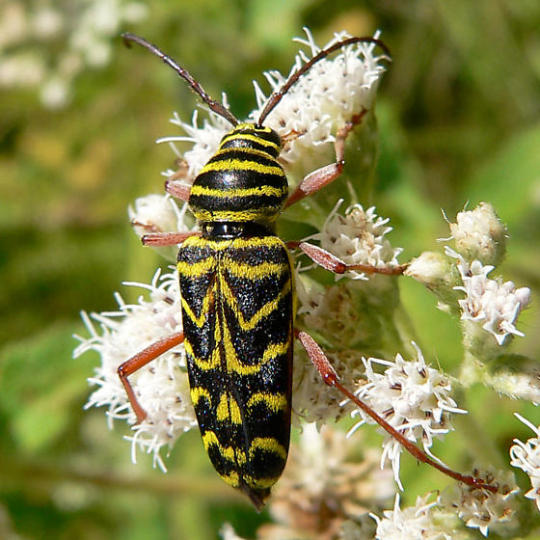
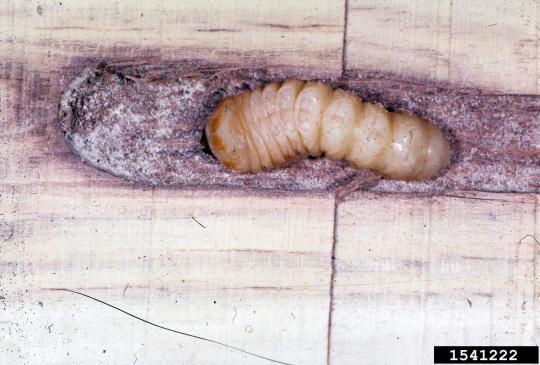

Locust Borer Beetle (Megacyllene robiniae)
Distribution: Originally found only in the northeastern USA, but now found throughout the USA and southern Canada.
Habitat: Usually found in areas where the black locust tree Robinia pseudoacacia is present, especially where goldenrod can also be found; usually uncultivated fields and meadows.
Diet: Larvae feed on woody tissues of the black locust tree; adults feed on the pollen of goldenrod flowers.
Description: The locust borer beetle is a serious pest of black locust trees, singlehandedly destroying the value of what is otherwise an extremely valuable timber tree. Female beetles lay their eggs near wounds or in crevices, where newly-hatched larvae will overwinter. In the spring, they bore into the tree bark, forming tunnels 10 centimetres long and 0,7 centimetres wide. These tunnels serve as an infection site for fungi, which can infect the trees and render them stunted and diseased. Trees suffering from drought and those growing in open areas, like roadsides, or in eroded or nutrient-deficient soil are especially vulnerable to attack. This species isn't known to feed on any other tree species.
(Images by 1) Marcie O'Connor (adult), 2) Lacy L. Hyche (larva) and 3) James Solomon (damage))
11 notes
·
View notes
Text
Saw a Solidago today that was crawling with yellow and black insects.

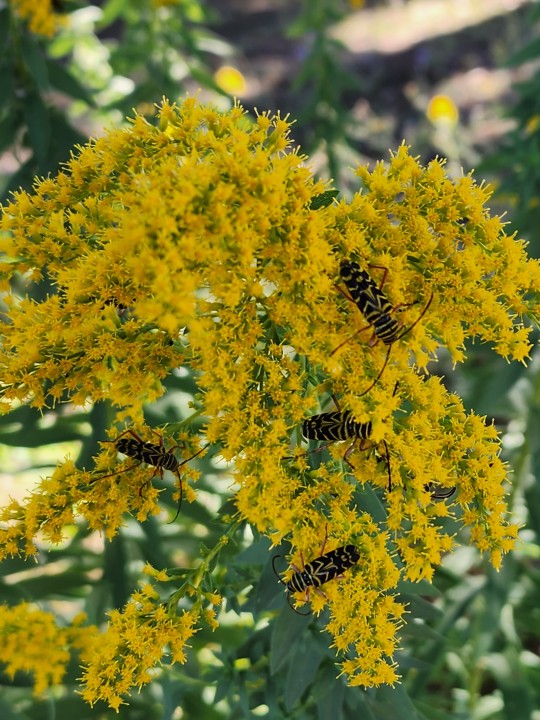
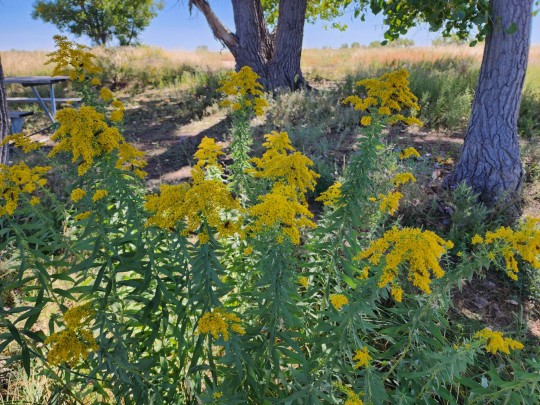
Image ID. Some yellow goldenrod flowers with a bunch of bugs on it. End ID.
At first I thought it was just the beetles (locust borers, Megacyllene robiniae), but there were also a couple wasps (Polistes sp. and somebody from Halictidae) and wasp mimic hover flies (probably Spilomyia).

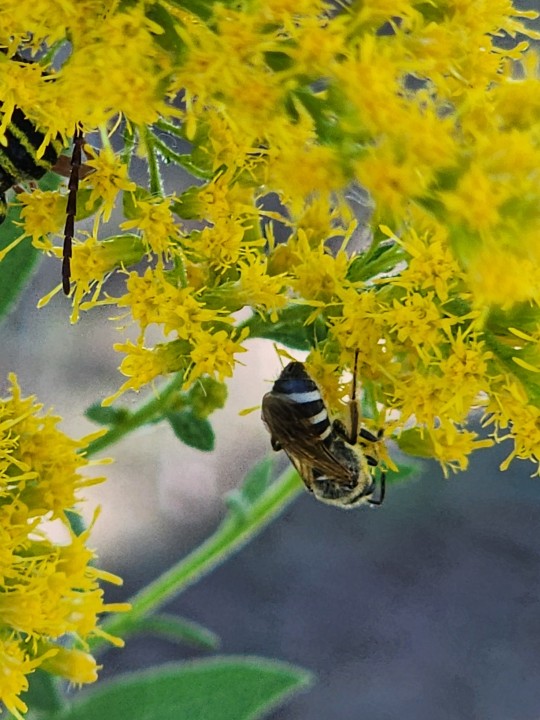


Image ID. Closer shots of the bugs in question. All are striped in bright yellow and black, but they are a beetle, a bee, a fly, and a wasp. End ID.
#insects#harper talks#solidago#wasps#hymenoptera#coleoptera#beetle#mimicry#biology#diptera#flies#goldenrod
8 notes
·
View notes
Text


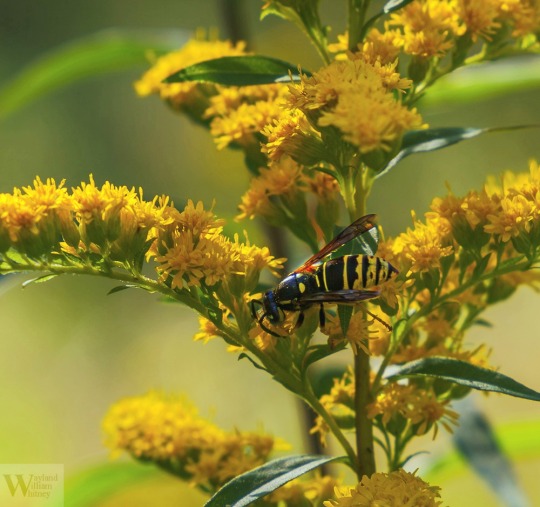
Top (my own photos): Long-horned beetle [Cerambycidae family] (Megacyllene robiniae), a.k.a. locust borer beetle on rabbitbrush (chamisa) (Ericameria nauseosa). Mimicry (of wasp) or camouflage on rabbit brush - or both?
Bottom: Wasp on Rabbit brush
2 notes
·
View notes
Note
Trick or treat!
ha TRICK

LOCUST BORER (Megacyllene robiniae) BE UPON YE
6 notes
·
View notes
Text
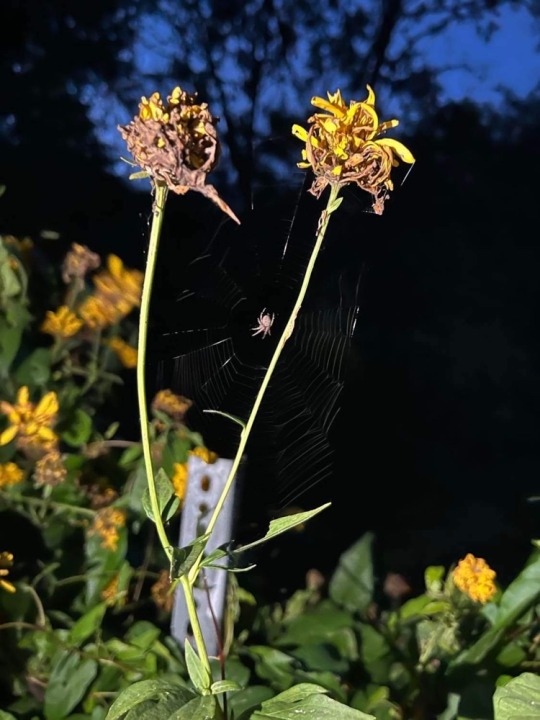
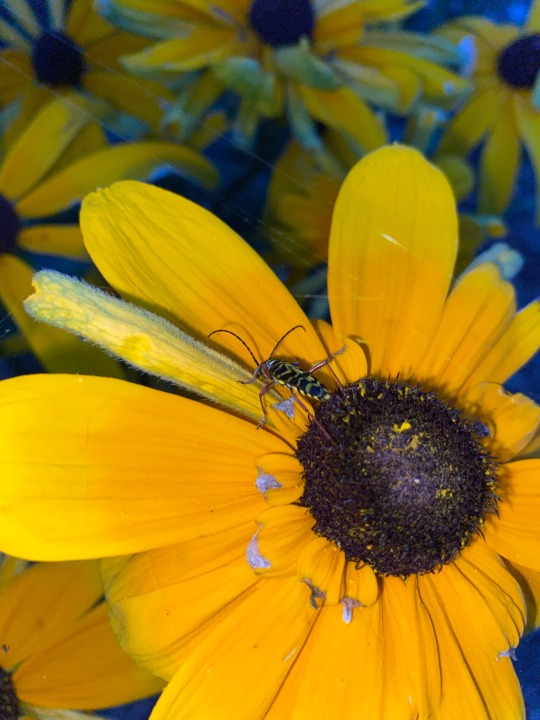
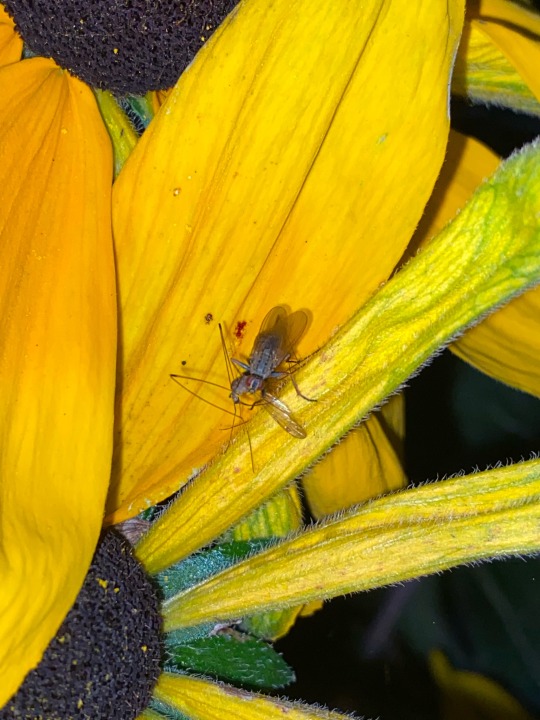
Some interesting fellows found during a late night walk by the lake
#insects#spiders#flowers#wildlife#nature#we actually watched the first little spider make that web#it was incredible it built it so quickly#thanks fly guy! I actually was really suprised to see a fly like that hunt!#grey cross spider#larinioides sclopetarius#pretty sure#araneae#araneidae#Locust borer#Megacyllene robiniae#cerambycidae#Scathophaga stercoraria#Scathophagidae#diptera#coleoptera#arachnids#north american species#my photos
9 notes
·
View notes
Photo
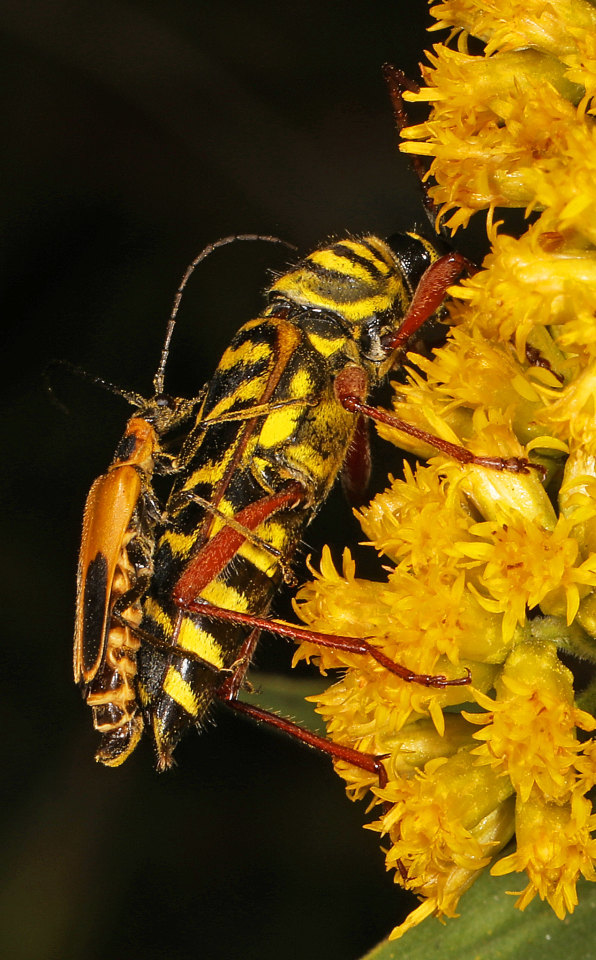
Male goldenrod soldier beetle (Chauliognathus pensylvanicus) attempting to mate with a female locust borer (Megacyllene robiniae)
Photographed in Virginia by Judy Gallagher
#animals#curators on tumblr#insects#bugs#beetle#longhorn beetle#soldier beetle#goldenrod soldier beetle#pennsylvania leatherwing#locust borer#one nice bug#spoiler: she ignored him
222 notes
·
View notes
Text
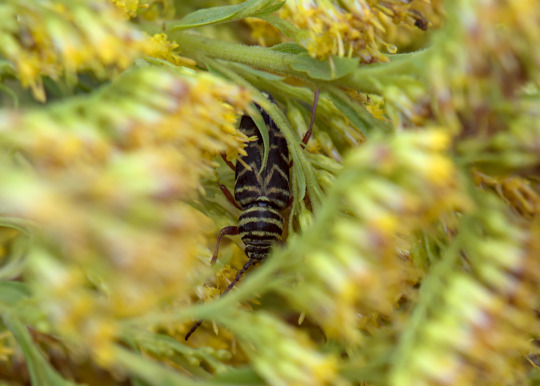
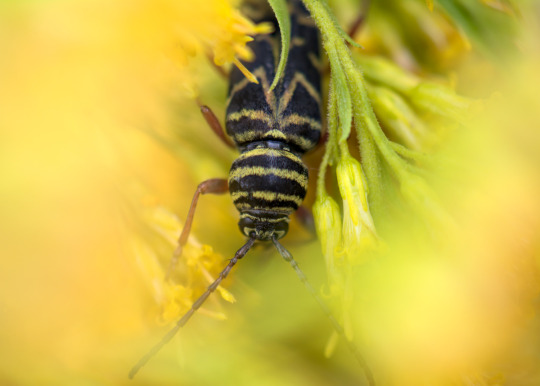
Locust Borer (Megacyllene robiniae)
3 notes
·
View notes
Text
What Bug Is This? 92: Locust Borers

Image Source: Bruce Marlin, license
Common name(s): locust borers
Scientific name: Megacyllene robiniae
Can it hurt me?: No
Can it hurt my plants?: They can do serious damage to locust trees. As larvae, they bore through locust wood (which is how they got their name) weakening the tree they live in and opening it up to easier infection by pathogens because the tree has all these new tunnels in it that fungi just love to grow in.
Should I kill it?: If you’re concerned about them, talk to a pest management specialist about them, though I’m not about to tell you to kill them on sight.
Anything else I should know?: Sometimes they are confused for bees or wasps, which is understandable given their coloration. It’s possible they evolved this pattern to deter predators since not everything willing to eat a beetle is willing to go for a wasp. Since they are beetles, they are incapable of stinging you.
You’re most likely to see adults around in late summer/early fall hanging around on goldenrod flowers.
30 notes
·
View notes
Photo

This time of year it is not uncommon to find the recently-emerged adult Locust Borer (Megacyllene robiniae) feeding on goldenrod where black locust trees are also found. The larvae, hatched from eggs laid in the autumn, burrow under the bark of black locust trees where they spend the winter. The larvae cause damage to the locust trees and pupation is completed by late summer when the adults emerge.
18 notes
·
View notes
Photo
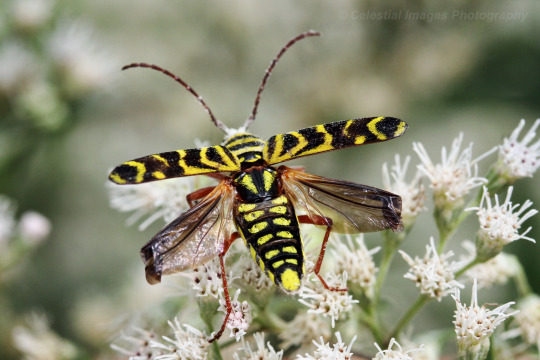
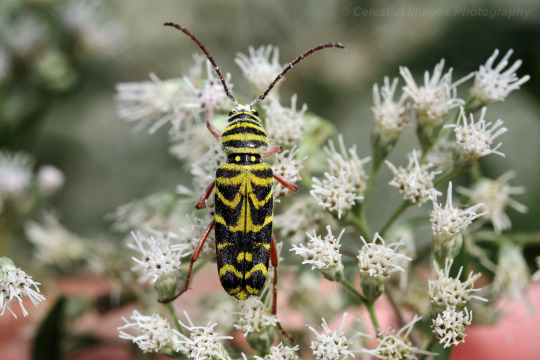
The moment of lift-off
Locust Borer (Megacyllene robiniae)
September 14, 2020
Southeastern Pennsylvania
#First one I've ever seen that wasn't on goldenrod#bug#bugs#photographers on tumblr#beetle#beetles#Megacyllene robiniae#locust borer#bugblr#entomology
459 notes
·
View notes
Photo
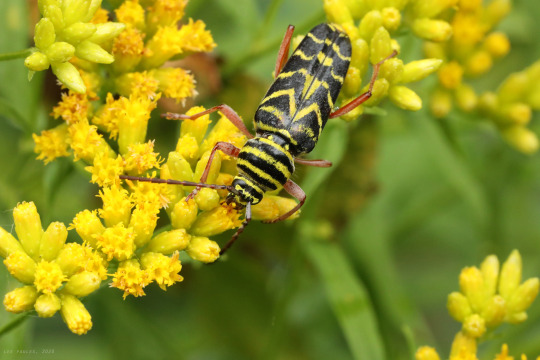
A locust borer beetle (Megacyllene robiniae) digs for summer gold in the budding flowers of grass-leaved goldenrod (Euthamia graminifolia).
#appalachia#vandalia#west virginia#flora#summer#wildflowers#asteraceae#euthamia#grass-leaved goldenrod#flat-topped goldenrod#beetle#insect#locust borer#megacyllene#coopers rock state forest
10 notes
·
View notes
Text
An Annual Return to My Bug-loving Roots

Image used by permission of Stuart Tingley, Cormierville, New Brunswick, Canada. Megacyllene robiniae (Forster), female on bloom of goldenrod
It’s that time of year again when one of my favorite beetles, Megacyllene robiniae (Forster), is starting to appear. Called the “locust borer” due to its larva’s habit of feeding in the living wood of black locust trees, it is one of the last species of long-horned beetle (family Cerambycidae) to emerge in late summer. Adults can be found feeding on the flowers of goldenrod, starting around late August and persisting in the field well into October. The beautiful yellow and black patterned beetles are strikingly colored, but can be quite cryptic when resting on the flowers of goldenrod, which shares the same shade of yellow as the beetle. As long as a larval host source is nearby, a stroll in a field of goldenrod is sure to produce a few adults, boldly feeding on pollen in broad daylight, yet still difficult to visually sort out from the background of the flowers which they visit.
Megacyllene is a genus of Cerambycidae that elicits as much sentimental as scientific interest for me, because it was one of the first long-horned beetles I encountered as a kid. I can still remember coming home from school in the early autumn and heading out into a large field of goldenrod behind my Ohio home to look for the beetles. The only other species of Megacyllene present in Ohio and Pennsylvania is Megacyllene caryae (Gahan) – the “painted hickory borer.” Contrary to M. robiniae - it is one of the earliest cerambycids to emerge in late April to early May, the adults having eclosed in the fall and remaining in their pupal cells until spring. I vividly remember my grandfather bringing home a load of hickory firewood one January, unaware that it was infested with the beetles. Upon splitting a log, he found the adults in their pupal cells awaiting the Spring warmth to emerge. He and I together split those logs smaller and smaller looking for more specimens. We ended up with a nice series of beetles and a bunch of wood whittled down to kindling size!

Image used by permission of Shannon Schade, Elkton, MD. Megacyllene caryae (Gahan), mating pair
Monochamus notatus (Drury) is a spectacular species of long-horned beetle, common in Pennsylvania in stands of white pine. The larva feeds under the bark of dying or dead pine and its feeding can be heard as a high-pitched rasping sound as far as 20 feet from the tree. This behavior has earned the species the common name of “pine sawyer” – the noise resembling the sound of an old-fashioned two-man crosscut saw raking back and forth through a log.

Image used by permission of Carolyn Waddell, Bugguide #1184417, Creative Commons, Ottawa, Ontario, Canada. Monochamus notatus (Drury), male
When I was thirteen, while camping at Mohican State Park in north-central Ohio with my family, I was sitting at a picnic table eating lunch. Suddenly, a large male M. notatus came wafting through the campsite, its lengthy antennae trailing behind it, and looking about the size of a small bird to my young bug-enthusiast eyes. I dropped my food, jumped from the table, grabbed my net, and swept the beast out of the air – the first cerambycid beetle that I ever collected! I still have that specimen 46 years later and I attribute it with starting me on the road to specializing on the family Cerambycidae – now my strongest area of taxonomic expertise. I have seen millions of specimens of long-horned beetles from all around the globe during my career, but that one specimen generates more sentiment than the rest combined – I can still smell the pine scent in the air on that day I caught it.
Collecting insects as a kid was the gateway into an amazing world of diversity, and as it turned out, the foundation of what would become my career and lifelong passion. When I look at specimens I caught in those early years, they produce a flood of memories – of specimens caught and of those that got away; of woods where I memorized every fallen log and patch of flowers; of the copy of Josef Knull’s 1946 book “The Long-horned Beetles of Ohio,” with its pages worn and every word read over and over again a thousand times; even the long bike rides, carrying my net and jars out to areas remote from my home in search of “wild” areas in which to hunt for beetles. The specimens serve as little time machines – carrying me back to my childhood and the dawn of my interest in entomology. Going into the field now is more sophisticated, and structured, and planned – better gear, GPS units to record localities, a lifetime of experience to rely upon – not to mention a car that can take me farther afield. But those days of simple exploration, where nearly every venture outdoors uncovered some new wonder, will always be some of my most cherished memories – and those beetles on pins will always be the vehicles that carry me back to that wondrous time in my life.
Bob Androw is a Scientific Preparator in Invertebrate Zoology. Museum employees are encouraged to blog about their unique experiences and knowledge gained from working at the museum.
#Carnegie Museum of Natural History#Insect Collection#Invertebrate Zoology#Beetles#Insects#Bugs#Science#Anthropocene
23 notes
·
View notes
Text
If you don’t look, you won’t see the tiny beautiful things.
Locust borer (Megacyllene robiniae) on goldenrod (solidago).
Song performed by Etta Cameron.
1 note
·
View note
Text
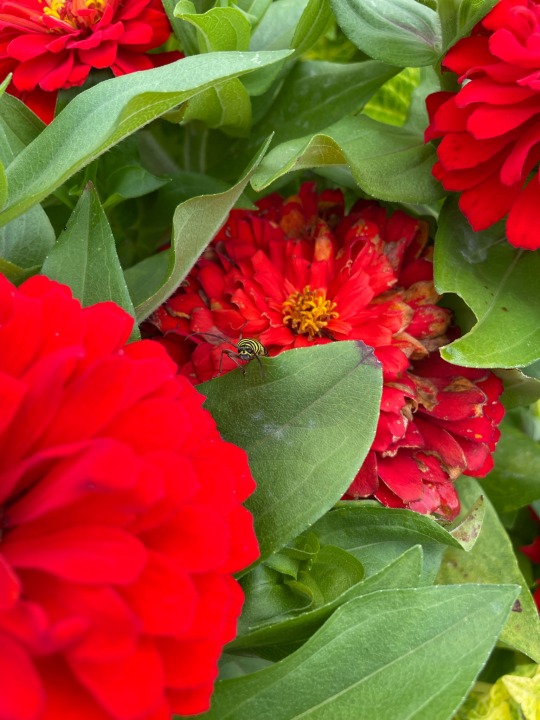
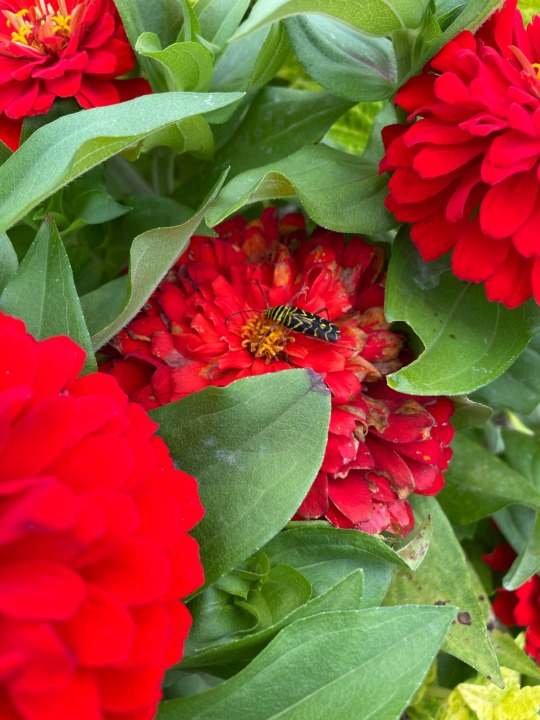
This stripey fellow looks like a locust borer (Megacyllene robiniae)!
0 notes